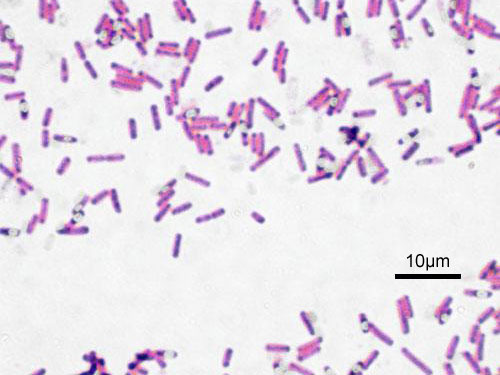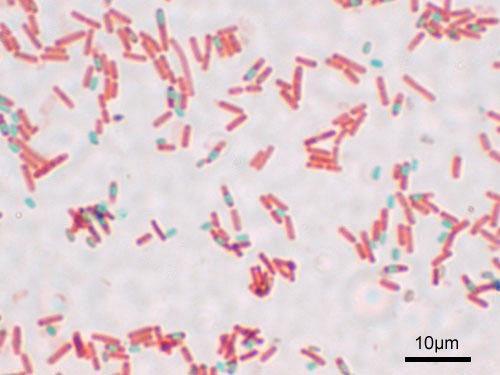Bacillus subtilis


| Bacillus subtilis | ||||||||||||||
|---|---|---|---|---|---|---|---|---|---|---|---|---|---|---|
| TEM micrograph of a B. subtilis cell in cross-seciton (scale bar = 200 nm). | ||||||||||||||
| Scientific classification | ||||||||||||||
| ||||||||||||||
| Binomial name | ||||||||||||||
| Bacillus subtilis (Ehrenberg 1835) Cohn 1872 |
Editor-In-Chief: C. Michael Gibson, M.S., M.D. [1]
Overview
Bacillus subtilis is a Gram-positive, catalase-positive bacterium commonly found in soil.[1] A member of the genus Bacillus, B. subtilis has the ability to form a tough, protective endospore, allowing the organism to tolerate extreme environmental conditions. Unlike several other well-known species, B. subtilis has historically been classified as an obligate aerobe, though recent research has demonstrated that this is not strictly correct.[2]
It has also been called Bacillus globigii, Hay bacillus or Grass bacillus.
Pathogenesis
B. subtilis is not considered a human pathogen; it may contaminate food but rarely causes food poisoning.[3] B. subtilis produces the proteolytic enzyme subtilisin. B. subtilis spores can survive the extreme heating that is often used to cook food, and it is responsible for causing ropiness — a sticky, stringy consistency caused by bacterial production of long-chain polysaccharides — in spoiled bread dough.
Reproduction
B. subtilis can divide asymmetrically, producing an endospore that is resistant to environmental factors such as heat, acid, and salt, and which can persist in the environment for long periods of time. The endospore is formed at times of nutritional stress, allowing the organism to persist in the environment until conditions become favorable. Prior to the decision to produce the spore the bacterium might become motile, through the production of flagella, and also take up DNA from the environment.
Replication of the chromosome
Bacillus subtilis duplicates its single circular chromosome by initiating DNA replication at a single locus, the origin (oriC). Replication proceeds bidirectionally and two replication forks progress in the clockwise and counterclockwise directions along the chromosome halves. Chromosome replication is completed when the forks reach the terminus region, which is positioned opposite to the origin on the chromosome map, and contains several short DNA sequences (Ter sites) that promote replication arrest. Specific proteins mediate all the steps in DNA replication. The comparison between the sets of proteins involved in chromosomal DNA replication in B. subtilis and in Escherichia coli reveals both similarities and differences. Although the basic components promoting initiation, elongation, and termination of replication are well conserved, some important differences can be found (such as one bacterium missing proteins essential in the other). These differences underline the diversity in the mechanisms and strategies that various bacterial species have adopted to carry out the duplication of their genomes.[4]
B. subtilis as a model organism
B. subtilis has proven highly amenable to genetic manipulation, and has therefore become widely adopted as a model organism for laboratory studies, especially of sporulation, which is a simplified example of cellular differentiation.[5] It is also heavily flagellated, which gives B.subtilis the ability to move quite quickly. In terms of popularity as a laboratory model organism B. subtilis is often used as the Gram-positive equivalent of Escherichia coli, an extensively studied Gram-negative rod.
Uses
B. subtilis is used as a soil inoculant in horticulture and agriculture. B. subtilis has been used for a biowarfare simulant during Project SHAD (aka Project 112).[2] B. subtilis hazard status is under dispute.[3]
Enzymes produced by B. subtilis and B. licheniformis are widely used as additives in laundry detergents.
Its other uses include the following:
- a model organism for laboratory studies
- a strain of B. subtilis formerly known as Bacillus natto is used in the commercial production of the Japanese delicacy natto as well as the similar Korean food cheonggukjang
- B. subtilis strain QST 713 (marketed as QST 713 or Serenade™) has a natural fungicidal activity, and is employed as a biological control agent
- can convert explosives into harmless compounds of nitrogen, carbon dioxide, and water
- plays a role in safe radionuclide waste [e.g. Thorium (IV) and Plutonium (IV)] disposal with the proton binding properties of its surfaces
- recombinants B. subtilis str. pBE2C1 and B. subtilis str. pBE2C1AB were used in production of polyhydroxyalkanoates (PHA) and that they could use malt waste as carbon source for lower cost of PHA production
Genome
B. subtilis has approximately 4,100 genes.[6] Of these, only 192 were shown to be indispensable; another 79 were predicted to be essential, as well.[7] Vast majority of essential genes were categorized in relatively few domains of cell metabolism, with about half involved in information processing, one-fifth involved in the synthesis of cell envelope and the determination of cell shape and division, and one-tenth related to cell energetics.
History
In 1835, the bacterium was originally named Vibrio subtilis by Christian Gottfried Ehrenberg,[8] and renamed Bacillus subtilis by Ferdinand Cohn in 1872.[9] In July of 1966, B. subtilis was released throughout the New York subway system, conducted by the U.S. Army's Special Operations Division, to test the vulnerability of the subway system to biowarfare that could kill more than a million civilians.[citation needed]
Treatment
Antimicrobial Regimen
- 1. Food poisoning
- Preferred regimen: supportive treatment
- 2. Other infections
- Preferred regimen (1): Vancomycin
- Preferred regimen (2): Clindamycin
- Alternative regimen (1): Ciprofloxacin
- Alternative regimen (2): Imipenem
- Note: Distinguish clinically significant infection from contamination before administering antibiotics.
References
- ↑ Madigan M; Martinko J (editors). (2005). Brock Biology of Microorganisms (11th ed. ed.). Prentice Hall. ISBN 0-13-144329-1.
- ↑ Nakano MM, Zuber P (1998). "Anaerobic growth of a "strict aerobe" (Bacillus subtilis)". Annu Rev Microbiol. 52: 165–90. doi:10.1146/annurev.micro.52.1.165. PMID 9891797.
- ↑ Ryan KJ, Ray CG (editors) (2004). Sherris Medical Microbiology (4th ed. ed.). McGraw Hill. ISBN 0-8385-8529-9.
- ↑ Noirot P (2007). "Replication of the Bacillus subtilis chromosome". Bacillus: Cellular and Molecular Biology (Graumann P, ed.). Caister Academic Press. ISBN 978-1-904455-12-7.
- ↑ Branda S, González-Pastor J, Ben-Yehuda S, Losick R, Kolter R (2001). "Fruiting body formation by Bacillus subtilis". Proc Natl Acad Sci U S A. 98 (20): 11621–6. PMID 11572999.
- ↑ Rivolta C, Pagni M (1999). "Genetic and physical maps of the Bacillus subtilis chromosome". Genetics. 151 (4): 1239–44. PMID 10101153.
- ↑ Kobayashi K, Ehrlich SD, Albertini A; et al. (2003). "Essential Bacillus subtilis genes". Proc. Natl. Acad. Sci. U.S.A. 100 (8): 4678–83. doi:10.1073/pnas.0730515100. PMID 12682299.
- ↑ Ehrenberg CG (1835). Physikalische Abhandlungen der Koeniglichen Akademie der Wissenschaften zu Berlin aus den Jahren 1833–1835. pp. 145–336. Check date values in:
|year=(help) - ↑ Cohn F (1872). "Untersuchungen über Bacterien". Beitr Biol Pflanzen. 1(Heft 1): 127–224.
- ↑ Bennett, John (2015). Mandell, Douglas, and Bennett's principles and practice of infectious diseases. Philadelphia, PA: Elsevier/Saunders. ISBN 978-1455748013.
- ↑ Gilbert, David (2015). The Sanford guide to antimicrobial therapy. Sperryville, Va: Antimicrobial Therapy. ISBN 978-1930808843.
- ↑ Andrews, J. M.; Wise, R. (2002-06). "Susceptibility testing of Bacillus species". The Journal of Antimicrobial Chemotherapy. 49 (6): 1040–1042. ISSN 0305-7453. PMID 12039902. Check date values in:
|date=(help)
See also
- Pages using duplicate arguments in template calls
- CS1 maint: Extra text
- CS1 maint: Extra text: authors list
- CS1 maint: Multiple names: authors list
- CS1 maint: Explicit use of et al.
- CS1 errors: dates
- Pages with broken file links
- All articles with unsourced statements
- Articles with unsourced statements from May 2007
- Articles with invalid date parameter in template
- Bacillaceae
- Infectious Disease Project